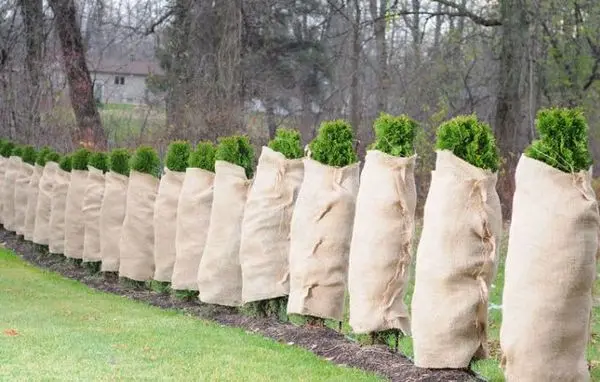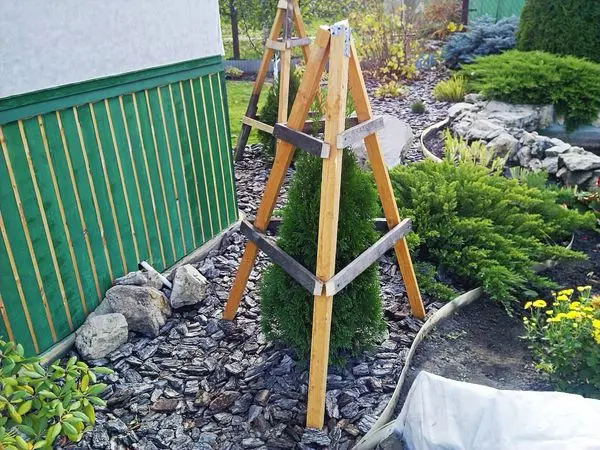Contents
Thuja is a conifer of the Cypress family, whose homeland is North America. The variety of colors and shapes of representatives of the genus attracts many gardeners. As for plant care, it is extremely simple. Do I need to cover the thuja for the winter – a question that often worries the owners of this plant.
When and why is shelter needed?
Thuja is a frost-resistant plant, in most cases it does not require additional warming. But there are certain varieties of shrubs that are not able to survive severe frosts without shelter. Also, young trees, whose age has not reached 2 years, need protection. However, not only frost poses a threat to the conifer. The scorching rays of the sun are also destructive, because they can simply burn the plant.

Preparing the conifer for winter should begin in early autumn. During this period, the dose of plant nutrition is reduced, otherwise it will continue to be active and will not “hibernate” in time. The shelter procedure is carried out with the onset of stable cold weather. But it is worth remembering that the air temperature should not be lower than +4 ° C. Otherwise, the plant, wrapped in thermal insulation material, may rot.
Before warming, the crown is cleaned of damaged, rotten, dried needles. After that, the waste is incinerated, as it can be pests and fungal diseases.
Video “Shelter of thuja for the winter”
From this video you will learn how to properly cover the thuja for the winter.
Root protection
Caring for thujas in the fall involves preparing the roots of the plant for winter. The ephedra is characterized by a superficial root system, so it is necessary to prepare this area for wintering especially carefully. The first stage of warming the rhizome is the collection of weeds in the root zone. Further, this area is well dug up and water-charging irrigation is carried out, which will saturate the earthen lump with liquid. Then fertilize with top dressing containing phosphorus and potassium.
When feeding a plant, it is important to observe the proportions indicated in the instructions. Excessive feeding activates the growth of thuja.
For direct warming of the near-stem zone, dry foliage, needles, peat, manure, compost, straw, spruce branches are used. Organic materials retain moisture well in the soil and protect thuja roots from cold winds and frosts.
Safe wintering of the plant
How to prepare thuja for winter depends on its appearance in the warm season. Properly selected shelter, proper care and technical performance of wrapping the conifer will protect it from the most severe frosts.
Covering materials
Before the construction of the shelter, the conifer is spirally tied with twine. This will prevent branches from being damaged by strong winds. A small thuja can be covered with an ordinary plastic bottle. Owners of high conifers should turn to special covering materials. The most popular are:
- agrospan;
- lutrasil;
- spunbond;
- agrofibre;
- sackcloth;
- gauze;
- kraft paper.
For those who choose insulation material, it is important to remember that the matter must be thin in order to pass air well. Polyethylene as a covering material is strictly prohibited, as it is airtight and accumulates excess moisture. Burlap and gauze are considered good options. They retain heat and at the same time provide air circulation.
Homemade covers are made from burlap. To do this, the plant is wrapped with material and fastened with a stapler. Shelter with gauze is produced in several layers, because the matter is much thinner than burlap. Thuja is wrapped from the top to the roots. Kraft paper is no less popular among summer residents. The principle of insulation with its help is the same: the thuja is wrapped with paper and fastened with a stapler.
Wireframing
For adult frost-resistant thujas, a thin covering material will suffice for a successful wintering. Young bushes require more substantial warming. Therefore, many summer residents prepare frames.
For their construction, you need:
- metal corners;
- laths;
- plastic tubes;
- wire;
- grinders.

To shelter low thujas, a frame with three supports will suffice, for high ones – with four. The support should be ⅔ of the length of the tree and be driven into the ground by 25 cm. A cover is pulled over the finished frame and fixed to the base of the structure. This method of shelter has one drawback – the need for regular cleaning of the surface of the greenhouse from snow. But smart gardeners have found a way out in this situation – they give the frame a spherical shape. Thanks to this, the snow itself rolls off the top of the structure.
Aftercare
Winter care for thuja is not limited to shelter alone. After carrying out the preparatory and warming procedures, the summer resident must systematically shake off the snow that accumulates on the “roof” of the structure. It is recommended to clear the root zone from snow.
You can remove the shelter only after the warm weather is established. It is also important to shade conifers to protect their foliage from the scorching sun.
Preparing for frost by region
The climatic features of a certain region play almost the main role in choosing a shelter method. Depending on the weather, the degree of warming of thuja is different. So, in the Moscow region, the root soil is mulched, and the tree itself is covered with cloth. For regions with relatively warm winters, such insulation is more than enough. Warming of thujas in the Volga region is the same as in the middle lane. The only difference in the mulch layer is that it should be 10 cm thicker. In the Urals, matter alone is not enough. A frame is built for shrubs, which protects not only from frost and cold wind, but also from heavy snowdrifts.
Depending on the variety, thuja can be either a shrub or a tree. Plants are often used in landscape design, forming hedges from them. Growing thuja is within the power of even a novice gardener. Caring for it does not require exorbitant effort and money. The main thing is attentive and caring attitude to your garden pet.









